How Do Hotels Keep Sheets White? Insider Laundry Techniques Revealed
Hotels are often associated with impeccably clean and crisp white sheets, creating a sense of luxury and cleanliness for guests. This stark whiteness is no accident; it is the result of a meticulous laundering process that combines industrial methods with precise chemical management. White sheets serve as a blank canvas that not only suggests comfort and hygiene but also allows for the thorough detection and treatment of any stains or discolouration.
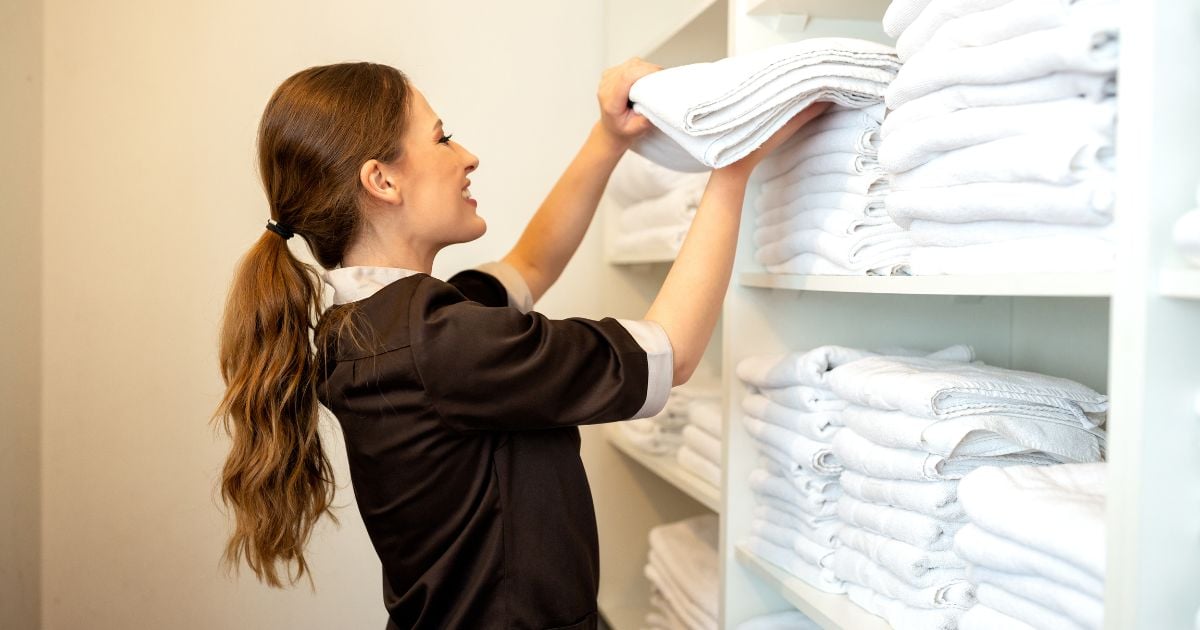
The hotel industry employs a series of best practices to ensure that their bedding remains pristine. These include the use of heavy-duty commercial washing machines that can handle large volumes of linen, as well as specialised detergents and bleaches that are more effective at removing stains and whitening fabrics than their household counterparts. Temperature control is also key, with hot water being instrumental in both disinfecting the linen and aiding in the removal of tough stains.
Moreover, to maintain the longevity and whiteness of their sheets, hotels often have strict protocols for sorting and pre-treating linens before washing. Stains are treated immediately and linens are sorted by type and level of soiling to prevent cross-contamination. This systematic approach allows for not only clean but also consistently white sheets that withstand the rigorous use within the hospitality sector.
The Fundamentals of Hotel Sheet Care
Maintaining the pristine white appearance of hotel sheets involves a systematic approach to laundry care, ensuring that these linens remain inviting and hygienically clean for guests.
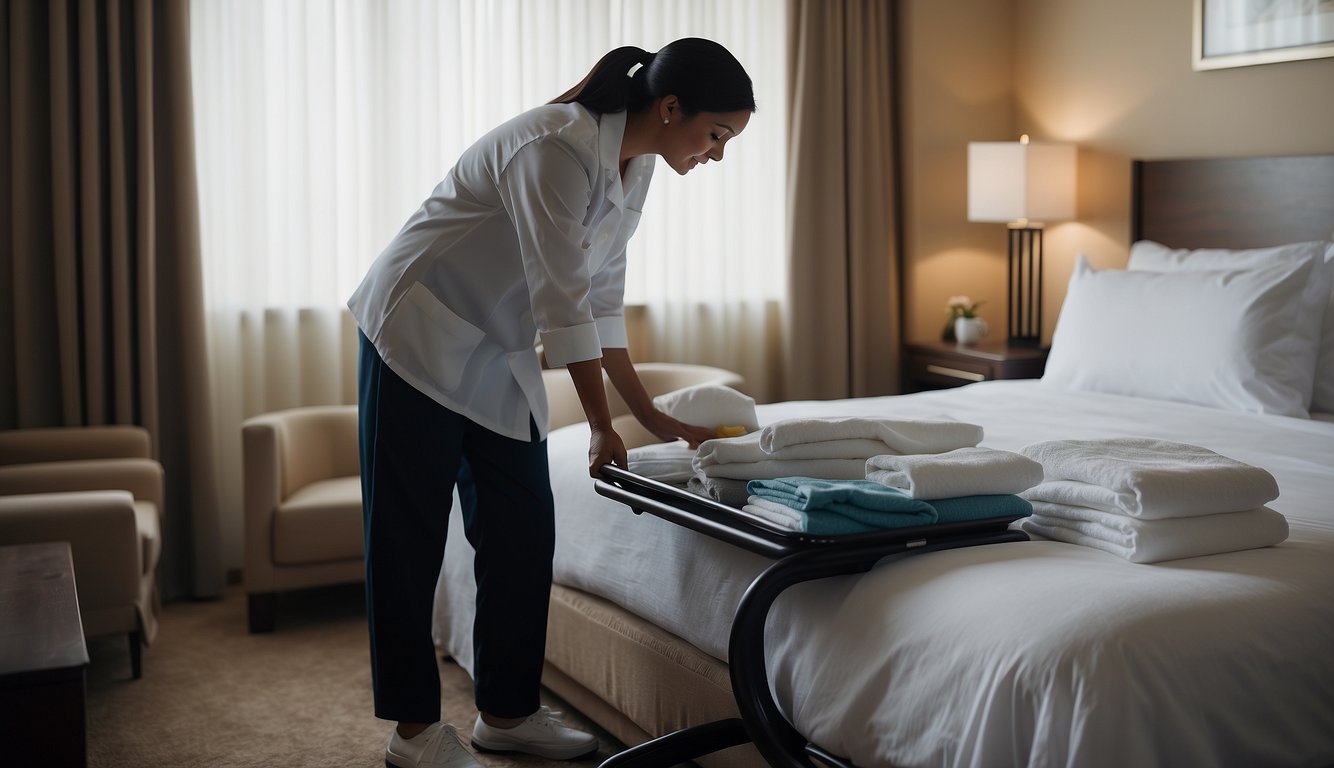
Understanding Hotel Laundry Systems
Hotels operate large-scale laundry systems that are designed to manage the high volume of linens that require daily washing. They employ commercial-grade washing machines with larger capacities and programmatic settings that help control various aspects of the cleaning process. Efficiency and consistency are pivotal in these systems to meet the relentless demand without compromising on quality.
Key Elements of Wash Cycles
In a hotel's laundry cycle, several factors are critical for keeping sheets white:
- Temperature: Hot water is often used for its ability to sanitise linens and effectively remove stains.
- Detergents: A combination of strong yet fabric-safe detergents is necessary to tackle stains and discolouration without damaging the fabric.
- Bleach: Non-chlorine bleach is preferred for its whitening capabilities, reducing the risk of fabric degradation.
- Cycle Length: Extensive wash cycles ensure thorough cleaning, but the duration is carefully balanced with the need to conserve water and energy.
The Importance of High-Quality Linen
Hotels invest in high-quality linen that is robust enough to withstand frequent laundering. This linen is typically composed of a high thread count and durable fibres, which contribute to longevity and the ability to maintain whiteness after multiple washes. The strength of the fibres reduces the likelihood of tears and pilling, preserving a smooth, welcoming texture for guests.
Effective Stain Removal Techniques
To ensure hotel sheets remain impeccably white, a meticulous stain removal regime is essential. From pre-treating marks to selecting the right cleaning agents, the process is critical for maintaining the pristine appearance of linen.
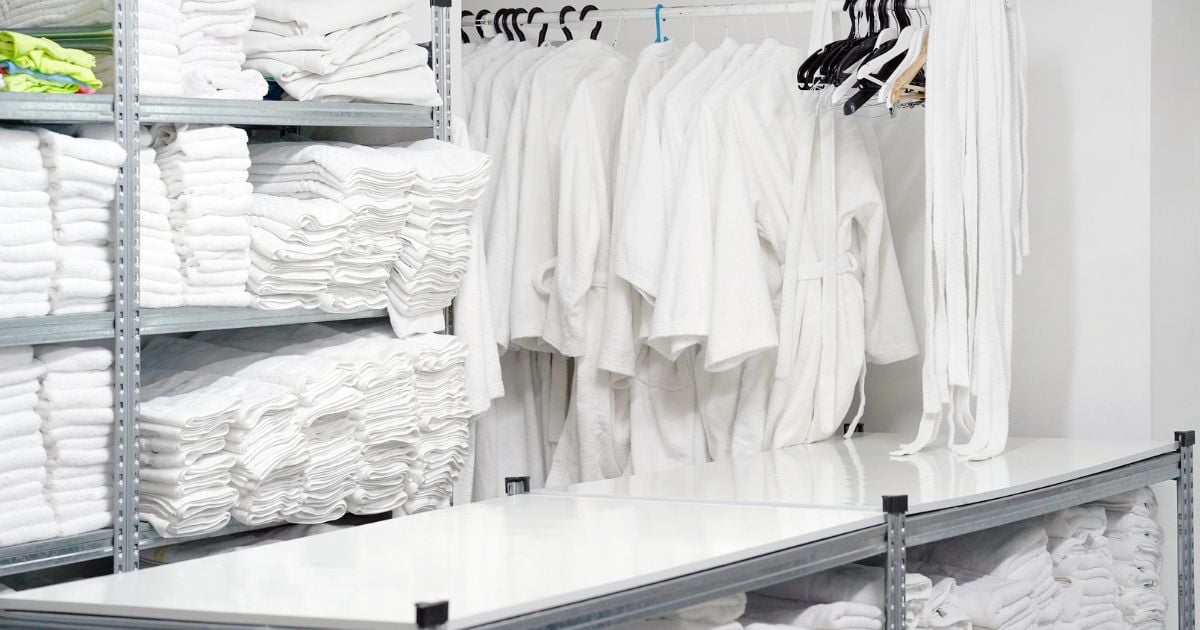
Pre-Treating Stubborn Stains
Pre-treatment is a crucial step when dealing with stains, particularly sweat and yellow stains which can be a common sight on sheets and mattresses. . Effective pre-treatment involves spot cleaning, where a targeted application of OxiClean Stain Remover or a similar product is applied directly onto the stain. This method ensures the breakdown of stains before sheets enter a washing cycle. Hotels often rely on this technique to tackle difficult spots, which enhances the efficacy of the subsequent wash.
- Spot Cleaning: Apply OxiClean directly onto stains
- Sweat/Yellow Stains: Pre-treat with peroxide-based solutions
Choosing the Right Detergents
Using the appropriate detergent is vital for sustaining the whiteness of hotel sheets. Detergents specifically designed for white fabrics, often containing optical brighteners, work best to remove dirt and grime without damaging the fabric. Some hotels opt for enzyme-based detergents which are effective at breaking down organic matter, such as bodily fluids, without compromising the fabric's integrity.
- Optical Brighteners: Enhance whiteness
- Enzyme-Based Detergents: Tackle organic matter effectively
The Role of Bleach in Keeping Sheets White
Bleach plays a significant role in maintaining the bright white colour of hotel sheets. Hotels often use a diluted solution of bleach in the washing process to remove any lingering stains and to disinfect the fabric. For more sensitive materials, a peroxide detergent might be utilised as a safer alternative to traditional bleach, providing effective whitening while being less harsh on the fabric.
- Bleach: Utilised for disinfecting and whitening
- Peroxide Detergent: A gentler alternative for sensitive fabrics
Best Practices for Washing and Drying
Maintaining the pristine whiteness of hotel sheets involves specific washing and drying protocols, ensuring longevity and hygiene.
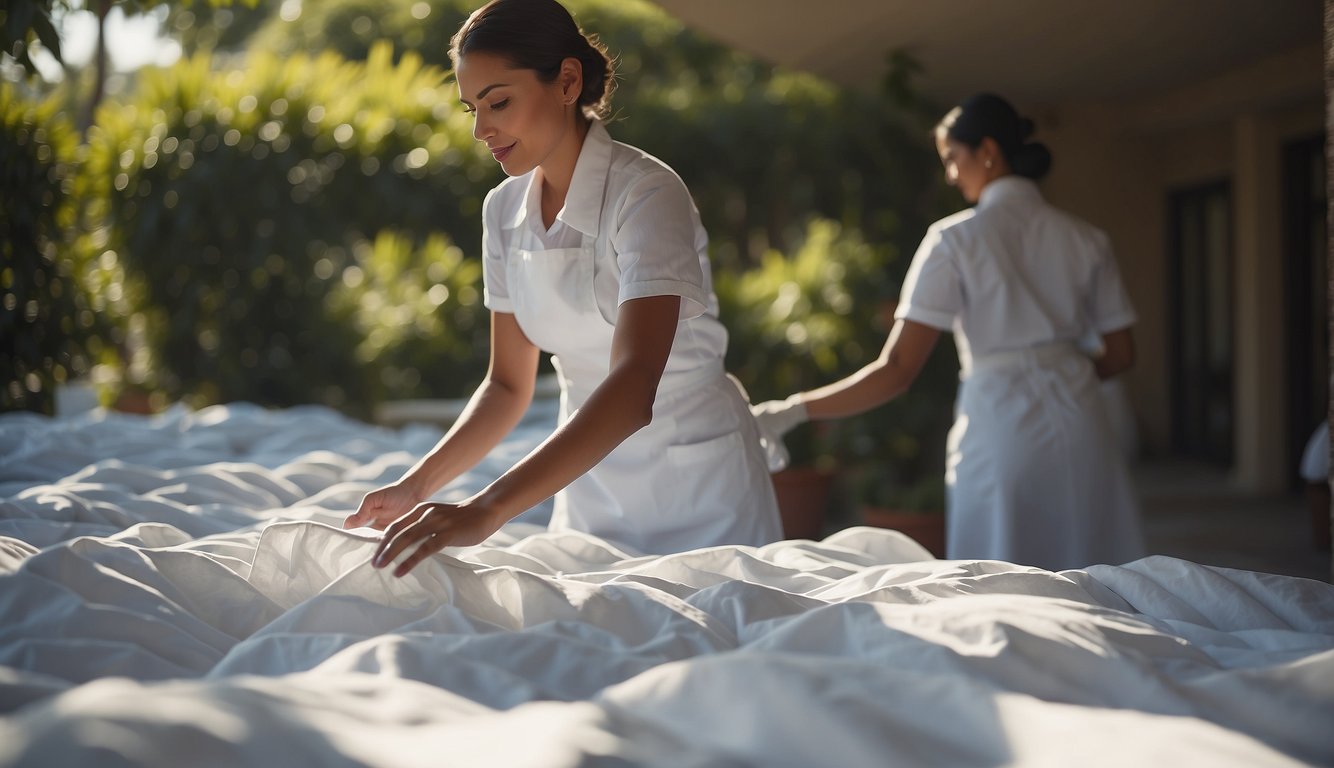
Optimal Washing Machine Settings
Hotels leverage high-capacity washing machines with customisable settings to tackle the demanding laundry loads. For white sheets, it's crucial to select a high-temperature wash cycle to maximise stain removal and disinfection. However, sheets with delicate fabrics may require a gentle cycle to prevent damage. It's advised to:
- Use a high-spin speed to extract maximum water, reducing drying time.
- Avoid overloading to ensure sheets move freely and are thoroughly cleaned.
The Use of Hot and Cold Water
Proper temperature selection is vital for sheet maintenance:
- Hot water (about 60°C to 70°C) is effective for removing tough stains and killing bacteria.
- Cold water is suitable for delicate items to prevent shrinking and reduce energy usage.
The choice of laundry detergent should be compatible with the water temperature to maintain sheet quality.
Proper Drying and Storage Techniques
After washing, proper drying is pivotal. Hotels tend to employ the following methods:
- Tumble dry sheets on a medium to high heat setting to achieve a crisp feel while minimising wrinkles.
- Sheets should be removed promptly to avoid setting wrinkles and to use less ironing effort.
- For the best results, fold and store sheets in a cool, dry place to prevent mildew and keep them fresh for future use.
Maintaining White Sheets and Bedding
Hotels meticulously preserve the crisp, white appearance of their sheets and bedding through dedicated cleaning regimens and the use of specific non-chemical treatments, underpinned by strategies that enhance the durability of these linens.
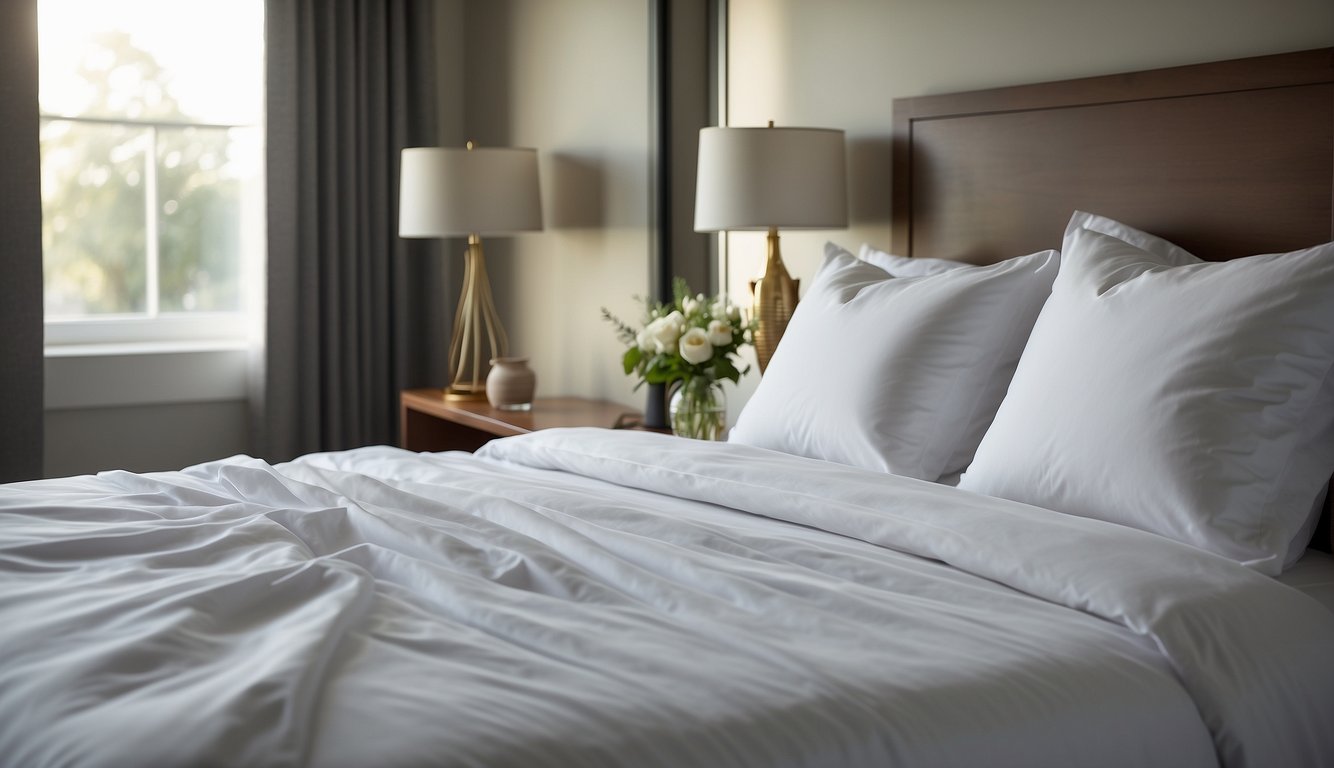
Routine Cleaning Schedules
Hotels establish rigorous cleaning schedules to ensure that white sheets and bedding are washed regularly. They typically utilise industrial washing machines that handle large capacities and operate at high temperatures, which is crucial for maintaining whiteness.
- Pre-treatment: Stains are pre-treated with stain removers like peroxide or borax before the main wash to keep the bedding pristine.
- Main Wash: A combination of hot water and commercial-grade bleach is used, with a precise measurement to protect the fabric while effectively eliminating stains.
- Final Rinse: After the wash, a final rinse incorporating white vinegar can help in removing any residual soap and maintaining the brightness of the sheets.
The Integration of Non-Chemical Solutions
While chemicals play a vital role in cleaning, hotels also employ natural agents to assist in the laundering process.
- Baking Soda: Known for its mild abrasive and natural whitening properties, baking soda is often added to the wash to boost cleaning power and deodorise the fabric.
- Vinegar Solutions: A measured quantity of white vinegar can be used as a fabric softener in the final rinse cycle, aiding in whitening and keeping the integrity of the white sheets.
Ensuring Longevity of White Bedding
To prolong the life span of white bedding and textiles, hotels adopt certain practices:
- Protective Layers: Pillow protectors and duvet covers serve as barriers against direct contact and soiling, reducing the frequency of washes needed for the actual pillow and duvet.
- Careful Bleach Usage: Bleach is used judiciously to avoid fabric degradation, with alternatives such as peroxide used where suitable to maintain fabric integrity.
Fabric Choice: Choosing the right fabric is also paramount. Many establishments opt for white bedding made from durable materials that can withstand repeated washing without losing their whiteness or comfort.
Advanced Linen Treatment Options
In the appraisal of linen management within hotels, specialised products and innovations hold the key to maintaining the prestigious standard of whiteness and quality.
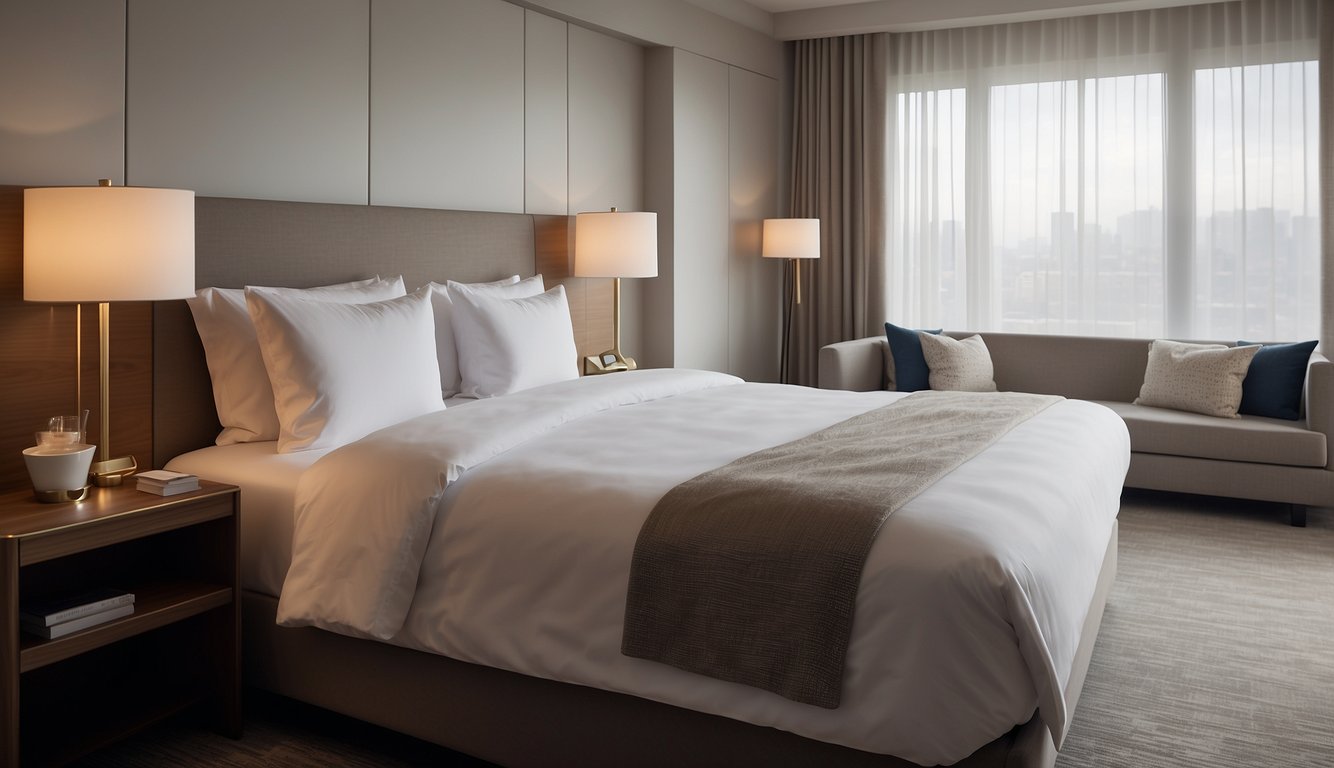
Specialised Products for Hotel Use
Hotels invest in specialised laundry detergents to achieve superior laundry results, often prioritising products that contain optical brighteners and stain-removing enzymes. These detergents work in tandem to break down difficult biological stains whilst simultaneously enhancing the fabric's brightness. A popular additive is a biological soap, a detergent type noted for its enzymes that efficiently digest proteins and fats commonly found in stains.
In addition, fabric softeners are formulated specifically for hotel use to ensure that linens not only appear clean but feel luxuriously soft to the touch. The use of softeners is carefully managed, as the right amount improves softness without compromising the towel’s absorbency or the crispness of bed linens.
- Detergents: Contain brighteners and enzymes for stain removal.
- Softeners: Achieve luxury and softness; quantity is balanced for optimal texture.
Innovations in Fabric Care
Technological advancements in fabric care play a pivotal role in linen maintenance, extending the lifespan of hotel sheets while preserving their pristine appearance. Innovations such as low-temperature washing systems can effectively sanitise linens while conserving energy and reducing linen wear.
Another progressive technique is the use of UV light treatments, an eco-friendly method that not only sterilises fabric but also aids in achieving long-lasting whiteness without the need for harsh chemicals.
- Low-Temperature Wash: Sanitises effectively, conserves energy, minimises wear.
- UV Light Treatment: Sterilises and sustains whiteness without harsh chemicals.
Amenities and Additional Linen Care
Hotels often provide an array of amenities along with superior linen maintenance to ensure all bedding remains pristine. This section sheds light on the care of complementary items and the best practices for linen storage.
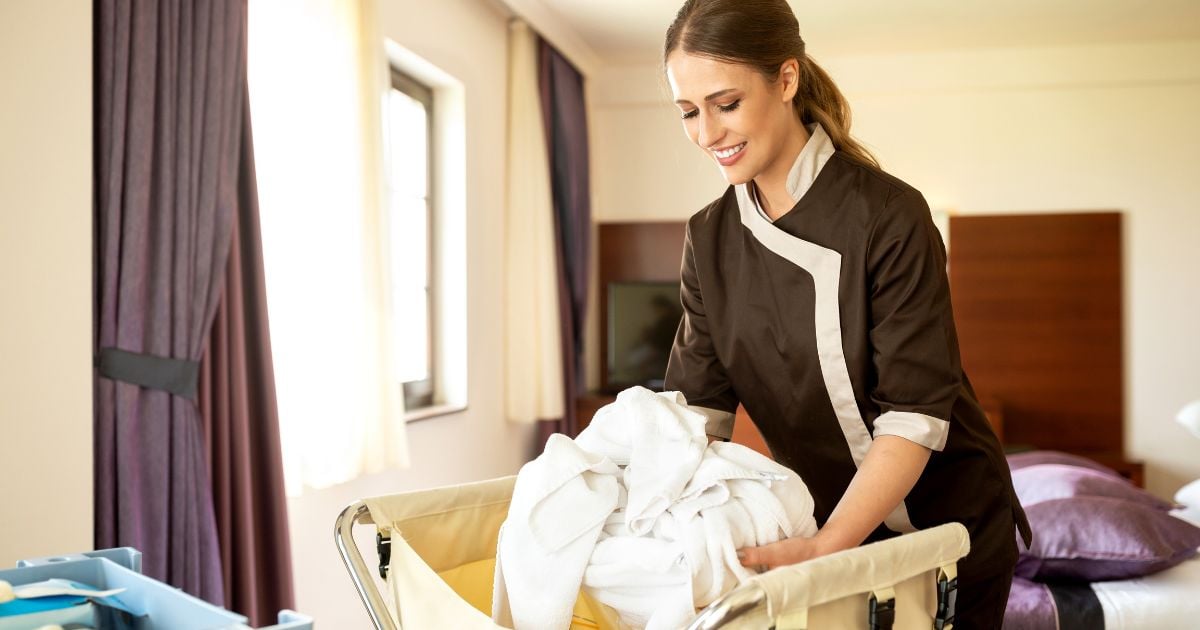
Caring for Complementary Items
Hotels typically offer a variety of complementary items such as towels, comforters, and soaps. These items require attentive care to maintain their white appearance. The use of oil-based products near towels and comforters is minimised to prevent stains. Bathroom amenities, like soaps, are often chosen for their mildness to avoid damaging the fibres of the linen.
- Towels and Comforters: Treated with stain removers specifically designed for hotel use.
- Pre-treatment for stains
- Washing with non-harsh detergents
- Soaps: Selected to reduce residue left on fabric.
Best Methods for Storing Linen Products
Maintaining the whiteness of hotel bedding calls for meticulous storage strategies. A hotel linen service provider may advise on the best practices, which include keeping the linen in a dry, cool place away from direct sunlight.
- Dryers: Used with care to prevent overheating, which can cause yellowing.
- Optimal temperature setting
- Timely removal to minimise wrinkling
Linen products are often stored in breathable containers to avoid the accumulation of moisture, which can lead to mildew. Rigorous linen maintenance protocols ensure longevity and consistent quality.
Hotel Bedding Storage:
|
Linen Item |
Storage Recommendation |
|
Sheets |
Folded, stacked, and stored in a dry area |
|
Comforters |
Aired out before storage in breathable bags |
|
Towels |
Kept separate from cleaning materials |
- Superior Linen: Regularly inspected for signs of wear and promptly rotated out.
- Frequent quality checks
- Replacement of items showing signs of ageing
By investing in quality linen maintenance, hotels ensure that all guests experience the highest standard of cleanliness and comfort.
Strategies for Upkeep of Hotel Sheets
Maintaining the pristine whiteness of hotel sheets involves the meticulous training of housekeeping staff and the coordination with specialised linen service providers. These stakeholders employ specific techniques and resources to ensure that sheets remain clean, fluffy, and present a luxurious feel to the guests.
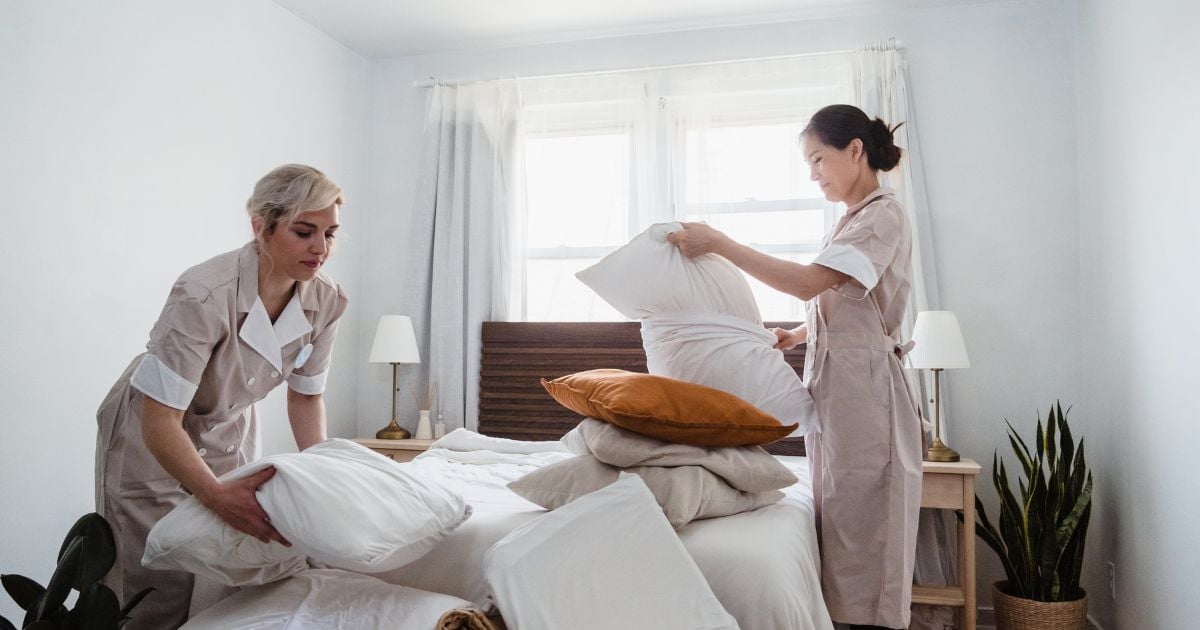
Training and Education for Staff
Housekeeping staff in luxury hotels undergo a comprehensive training programme designed to meet high standards of cleanliness and linen care. They learn to handle and launder bed linens using:
- Professional-grade laundry detergents formulated to tackle stains while preserving the fabric's integrity.
- Advanced washing and drying equipment that optimises cleaning efficiency and fabric care.
Housekeepers are educated on laundering cycles and the importance of following a set pattern to maintain consistency in the quality of the sheets. Furthermore, they are instructed in the techniques required to achieve that signature fluffy texture post-laundry, which is synonymous with luxury accommodation.
Working with Linen Service Providers
Luxury hotels often collaborate with reputable hotel linen service providers to ensure a constant supply of fresh and immaculately white sheets. These providers offer:
- Specified fabric blends that are easier to maintain and exhibit a luxurious feel.
- Precise laundering protocols, utilising specialised laundry detergents and additives that sustain the fabric's whiteness without causing harm.
- The use of professional equipment that reliably cleans and presses sheets to exacting standards.
Contracts with these providers typically include strict service level agreements to guarantee that the quality of laundered linens always aligns with the hotel’s standards. Through such collaborations, the hotels assure their guests of the highest level of comfort and hygiene.
Improving Guest Experience with Pristine Linens
Hotels understand that impeccable sheets are a crucial component of the guest experience; their condition directly influences satisfaction and reputation.
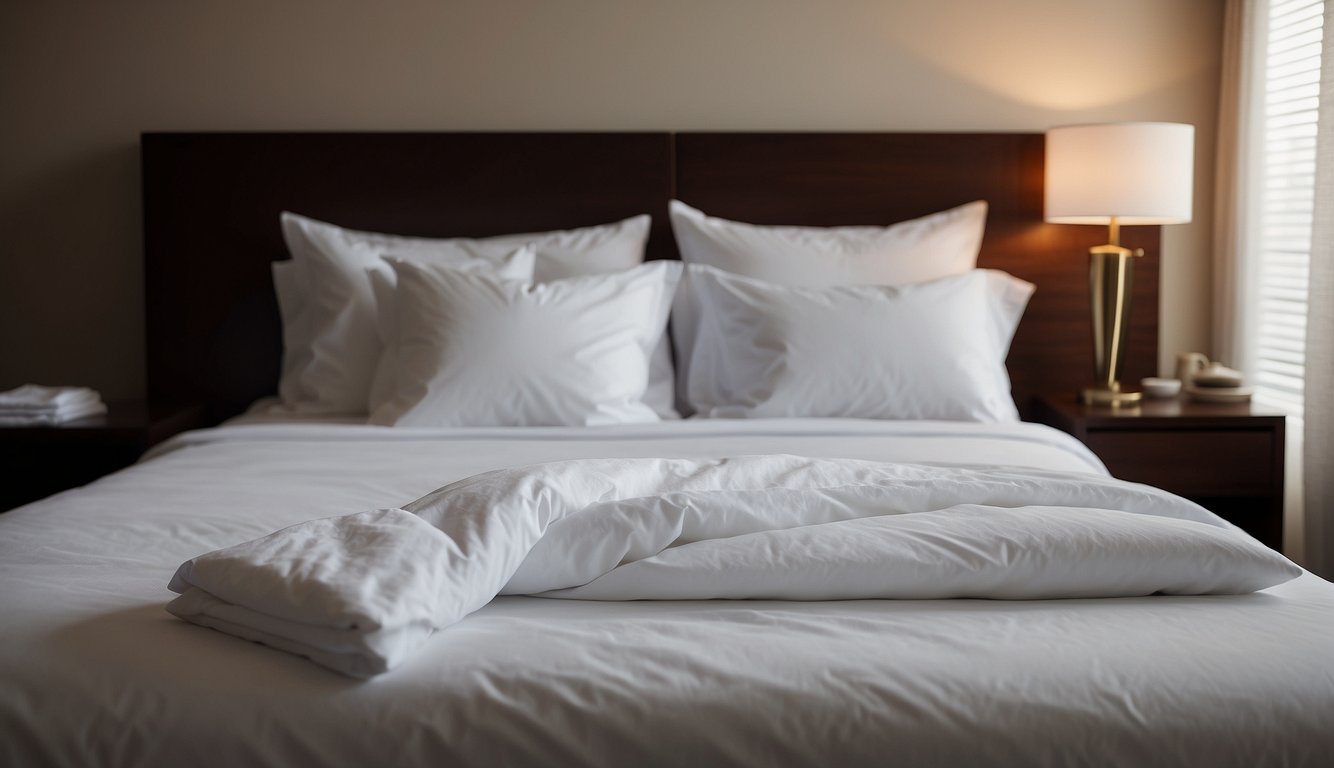
The Impact of Pristine Linens on Hotel Reputation
Hotels are cognisant of the significant role that quality sheets play in their overall reputation. Pristine linens are not merely an expectation; they are a symbol of the hotel’s standards and attention to detail.
A survey conducted by the American Hotel & Lodging Association (AHLA) found that most travellers chose cleanliness as the most important factor when determining their next hotel stay. Also, 81% of travellers were more comfortable staying at hotels that showed enhanced protocols and standards.
- Textile Care: Comprehensive care protocols, beyond simple washing and ironing, are adopted to maintain the whiteness and crispness of hotel sheets, including the use of specialised detergents, whiteners, and fabric softeners.
- Investment: Hotels frequently invest in high-thread-count sheets and durable fabrics, which withstand the rigours of frequent laundering and still maintain their inviting appearance.
Frequently Asked Questions
Hotels use specialised cleaning techniques and products to keep their bed linens immaculately white and fresh. Dive into the specifics with these FAQs.
What methods do hotels employ to maintain the freshness of their linens?
Hotels often use a combination of high-temperature washing cycles and industrial-strength laundry equipment to maintain linen freshness. This process effectively removes stains and disinfects the fabric.
Which detergents are favoured by hotels for achieving pristine bed sheets?
Hotels typically use commercial-grade detergents that have higher concentration levels than regular household varieties. These detergents are specifically designed to tackle tough stains and maintain whiteness without causing fabric damage.
What steps are taken to restore the brightness of yellowed hotel sheets?
To combat yellowing, hotels may use bluing agents or optical brighteners during the washing process. These additives counteract the yellow tinge and revive the sheets' bright white appearance.
Can peroxide-based detergents be used to replicate the cleanliness of hotel linens at home?
Peroxide-based detergents are indeed an option for home use and can help remove stains and whiten sheets effectively. However, caution should be exercised as these agents are strong and can damage fabrics if not used correctly.
What laundry routine do hotels follow to ensure towels and sheets remain impeccably white?
Hotels consistently follow a strict laundry routine involving pre-soaking, using specified detergent quantities, rinsing thoroughly, and employing bleaching agents only when necessary. These steps are crucial to maintaining their white appearance over time.
Are there any specific techniques hotels use to keep their beddings looking new?
Hotels often implement rotation systems, where linens are cycled out to avoid overuse, and promptly repair or replace any items showing signs of wear. Proper drying and ironing further contribute to a like-new appearance.






